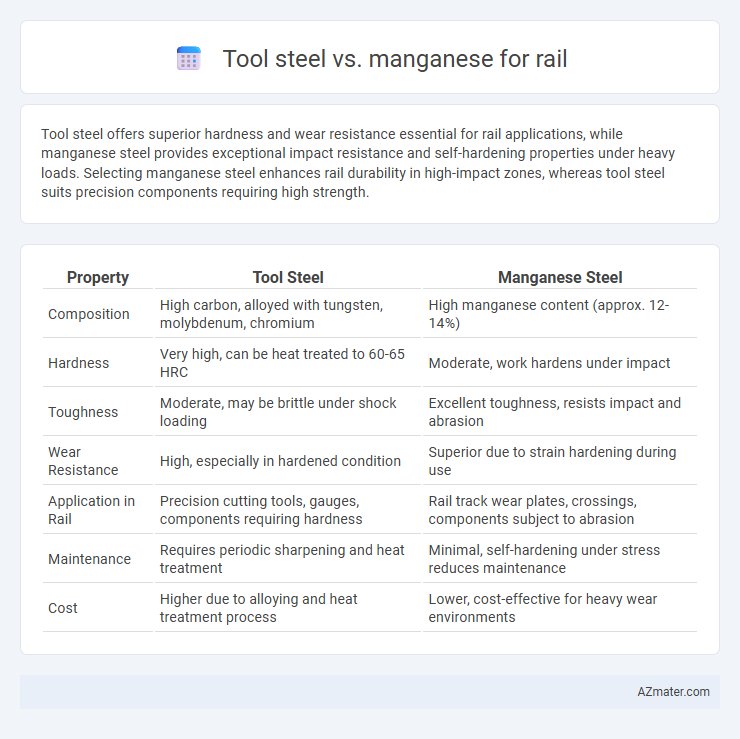Tool steel offers superior hardness and wear resistance essential for rail applications, while manganese steel provides exceptional impact resistance and self-hardening properties under heavy loads. Selecting manganese steel enhances rail durability in high-impact zones, whereas tool steel suits precision components requiring high strength.
Table of Comparison
| Property | Tool Steel | Manganese Steel |
|---|---|---|
| Composition | High carbon, alloyed with tungsten, molybdenum, chromium | High manganese content (approx. 12-14%) |
| Hardness | Very high, can be heat treated to 60-65 HRC | Moderate, work hardens under impact |
| Toughness | Moderate, may be brittle under shock loading | Excellent toughness, resists impact and abrasion |
| Wear Resistance | High, especially in hardened condition | Superior due to strain hardening during use |
| Application in Rail | Precision cutting tools, gauges, components requiring hardness | Rail track wear plates, crossings, components subject to abrasion |
| Maintenance | Requires periodic sharpening and heat treatment | Minimal, self-hardening under stress reduces maintenance |
| Cost | Higher due to alloying and heat treatment process | Lower, cost-effective for heavy wear environments |
Introduction to Rail Material Selection
Rail material selection prioritizes durability, wear resistance, and impact toughness to withstand heavy loads and harsh environmental conditions. Tool steel offers superior hardness and abrasion resistance essential for long-lasting rail performance, while manganese steel provides exceptional work-hardening properties that enhance resistance to deformation and cracking under high impact. Balancing these material properties ensures optimal rail longevity and safety in demanding rail applications.
Overview of Tool Steel Properties
Tool steel used in rail applications exhibits high hardness, excellent wear resistance, and strong toughness, making it ideal for heavy-duty environments with frequent impact and abrasion. Its alloy composition, typically including elements such as tungsten, molybdenum, and vanadium, enhances heat resistance and durability under high-stress conditions. Compared to manganese steel, tool steel maintains structural integrity at elevated temperatures and delivers consistent performance in precision-shaped rail components.
Overview of Manganese Steel Properties
Manganese steel, known for its exceptional hardness and high impact resistance, contains typically 11-14% manganese, offering superior toughness and wear resistance compared to standard tool steels. Its unique ability to harden upon impact makes it ideal for rail applications subjected to heavy abrasion and dynamic stresses. This steel type also exhibits excellent resistance to deformation, making it effective in extending the lifespan of rails under high load and repetitive impact conditions.
Mechanical Strength Comparison
Tool steel exhibits significantly higher tensile strength and hardness compared to manganese steel, making it more resistant to wear and deformation under heavy loads. Manganese steel, while having lower hardness, provides superior impact resistance and toughness due to its work-hardening properties, which enhances durability in abrasive rail environments. Mechanical strength in rail applications depends on balancing these characteristics, with tool steel offering enhanced load-bearing capacity and manganese steel excelling in impact absorption.
Wear Resistance in Rail Applications
Tool steel exhibits superior wear resistance compared to manganese in rail applications due to its high hardness and alloying elements such as chromium and vanadium that enhance abrasion resistance. Manganese steel, while offering exceptional toughness and impact resistance through work hardening, tends to have lower initial hardness, making it less effective against abrasive wear in high-friction environments. Optimizing rail durability requires balancing the hardness of tool steel with the deformability of manganese to address varied wear mechanisms under heavy load conditions.
Impact Toughness and Fatigue Performance
Tool steel exhibits superior impact toughness and fatigue resistance compared to manganese steel, making it ideal for rail applications subjected to high-stress conditions. The high carbon and alloy content in tool steel enhance hardness and wear resistance while maintaining structural integrity under repeated loading. Manganese steel, known for its work-hardening properties, offers good toughness but less fatigue performance, limiting its effectiveness in high-impact rail environments.
Machinability and Fabrication Considerations
Tool steel offers superior machinability compared to manganese steel due to its balanced carbon and alloy content, allowing precise cutting and shaping with minimal wear on tooling. Manganese steel, known for exceptional impact resistance and work-hardening properties, presents challenges in machining because of its high toughness and tendency to harden during fabrication. Selecting between tool steel and manganese for rail applications requires evaluating fabrication methods, as tool steel facilitates easier machining processes, while manganese demands specialized techniques like controlled heat treatment and heavy-duty cutting tools to maintain structural integrity.
Cost Analysis: Tool Steel vs Manganese Steel
Tool steel generally incurs higher upfront costs due to its alloying elements like tungsten, molybdenum, and vanadium, but offers superior wear resistance and longer service life in rail applications. Manganese steel is more cost-effective initially, with lower material and manufacturing expenses, yet it exhibits faster wear and requires more frequent maintenance and replacements. Life-cycle cost analysis often favors tool steel for heavy-duty rail operations despite higher initial investment, as reduced downtime and lower long-term maintenance improve overall cost-efficiency.
Case Studies: Rail Performance in Service
Case studies demonstrate that tool steel rails exhibit superior wear resistance and durability under heavy axle loads, significantly extending service life in high-traffic corridors. Manganese steel rails, while offering exceptional work-hardening properties, often require frequent maintenance due to surface deformation in abrasive conditions. Field performance data highlights that tool steel rails reduce lifecycle costs and downtime, making them preferable for demanding rail infrastructure environments.
Conclusion: Choosing the Optimal Rail Material
Selecting the optimal rail material hinges on balancing durability and wear resistance; tool steel offers superior hardness and strength for heavy-duty applications, while manganese steel provides exceptional toughness and impact resistance, reducing deformation. For high-impact, abrasive rail environments, manganese steel rails extend service life through self-hardening properties. Choosing between tool steel and manganese depends on specific rail conditions, load demands, and maintenance strategies to optimize performance and longevity.

Infographic: Tool steel vs Manganese for Rail
 azmater.com
azmater.com